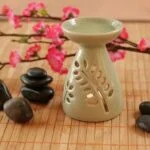Aromatherapy has become an increasingly popular complementary therapy in the field of midwifery, with practitioners and expectant mothers alike turning to essential oils for their various benefits. This article provides a comprehensive guide to Aromatherapy in Midwifery Practice PDF, offering valuable insights into the use of essential oils during pregnancy, labor, and postpartum care.
Understanding the Benefits of Aromatherapy in Midwifery is crucial for practitioners looking to enhance their approach to holistic care for expectant mothers. From promoting relaxation and reducing stress to alleviating common pregnancy discomforts, aromatherapy has been shown to offer a wide range of benefits for both the physical and emotional well-being of pregnant women.
Incorporating Aromatherapy into Midwifery Practice involves careful consideration of safety, appropriate usage, and understanding the various properties of essential oils. This section dives into practical ways that midwives can integrate aromatherapy into their care plans, enhancing the overall birthing experience for mothers and their families.
Understanding the Benefits of Aromatherapy in Midwifery
Aromatherapy has been gaining popularity in midwifery practice as a complementary approach to traditional care. The use of aromatic essential oils has shown to provide a myriad of benefits for both the mother and the baby during pregnancy, labor, and postpartum.
Aromatherapy has been used for centuries to promote relaxation, reduce pain, alleviate anxiety, and improve overall well-being. In the context of midwifery, it can be a valuable tool to enhance the birthing experience and support the physiological and emotional needs of expectant mothers.
One of the key benefits of aromatherapy in midwifery is its ability to promote relaxation and reduce stress. The calming effects of certain essential oils can help women manage their anxiety and fears associated with childbirth, leading to a more positive birthing experience. Additionally, aromatherapy has been found to relieve common discomforts during pregnancy such as nausea, back pain, and headaches without the need for medication.
Moreover, aromatherapy can also play a role in managing pain during labor. Certain essential oils have analgesic properties that can provide natural pain relief without the potential side effects of pharmaceutical interventions. By incorporating aromatherapy into midwifery practice, healthcare providers can offer women additional options for pain management that align with their preferences for holistic care.
| Benefit | Explanation |
|---|---|
| Promotes Relaxation | Aromatherapy helps manage anxiety and fears associated with childbirth |
| Natural Pain Relief | Essential oils have analgesic properties that offer pain relief during labor |
How to Incorporate Aromatherapy Into Midwifery Practice
Incorporating aromatherapy into midwifery practice can bring numerous benefits to both the midwife and the expectant mother. Aromatherapy has been used for centuries as a natural way to promote well-being, relieve stress, and manage pain. In the context of midwifery, it can be a valuable tool for supporting women during pregnancy, labor, and postpartum care.
One of the first steps in incorporating aromatherapy into midwifery practice is to educate oneself about the different essential oils and their potential uses. Understanding the properties and effects of each essential oil is crucial in creating tailored blends that can address specific needs of pregnant women. Additionally, it is important to stay up to date with the latest research on aromatherapy in midwifery practice, as new evidence continues to emerge regarding its efficacy and safety.
Once a midwife has a good grasp of aromatherapy basics, they can begin integrating it into their practice in various ways. This may include using diffusers in birthing rooms to create a calming atmosphere, providing expectant mothers with aromatic massage oils for relaxation during prenatal visits, or guiding women in using specific essential oils for pain management during labor.
It’s also important for midwives to communicate openly with their clients about aromatherapy and obtain informed consent before incorporating it into their care plan.
Finally, documenting the use of aromatherapy in midwifery practice and seeking feedback from clients will help build a body of evidence supporting its effectiveness. This can contribute to ongoing research efforts on the topic and further validate its integration into mainstream midwifery care.
| Benefits | Details |
|---|---|
| Natural Pain Relief | Aromatherapy essential oils like lavender and clary sage have been shown to help alleviate labor pains when used appropriately. |
| Emotional Support | The use of certain essential oils can promote relaxation, reduce anxiety, and provide emotional support during childbirth. |
| Faster Recovery | Postpartum aromatherapy interventions have been linked to faster recovery times for new mothers. |
Aromatherapy Essential Oils and Their Uses in Midwifery
Aromatherapy essential oils have been used for centuries to promote healing, relaxation, and overall well-being. In midwifery practice, these essential oils can be valuable tools for supporting women during pregnancy, labor, and postpartum. Here are some common essential oils used in midwifery practice and their specific uses:
- Lavender: Known for its calming properties, lavender oil can be used to help reduce anxiety and promote relaxation during labor.
- Chamomile: Chamomile oil is often used to soothe muscle pain and discomfort during pregnancy and postpartum recovery.
- Peppermint: Peppermint oil is useful for alleviating nausea and digestive issues that may arise during pregnancy or labor.
These are just a few examples of the many essential oils that can be beneficial in midwifery practice. It is important for midwives to have a good understanding of the properties and uses of each oil to ensure safe and effective application.
In addition to using single essential oils, midwives may also create blends tailored to the specific needs of their clients. Blends can be customized for pain management, emotional support, or to enhance relaxation. Understanding the properties of each oil is crucial when creating these blends.
Midwives should also consider the preferences and sensitivities of their clients when using aromatherapy. It’s important to discuss any potential allergies or aversions to certain scents with expectant mothers before incorporating aromatherapy into their care plan. By taking these factors into account, midwives can ensure that aromatherapy interventions are safe and beneficial for their clients.
Overall, when used appropriately, aromatherapy has the potential to enhance the birthing experience for women under the care of midwives. With a comprehensive understanding of essential oils and their uses, midwives can effectively incorporate aromatherapy into their practice while promoting safe and supportive care for expectant mothers.
Safety and Precautions for Using Aromatherapy in Midwifery
When incorporating aromatherapy into midwifery practice, it is crucial to prioritize the safety and well-being of both the mother and baby. Here are some important safety considerations and precautions for using aromatherapy in midwifery:
- Quality of Essential Oils: It is essential to ensure that only high-quality, therapeutic-grade essential oils are used in midwifery practice. Subpar or adulterated oils can be ineffective or even harmful.
- Dilution Ratios: Essential oils should always be properly diluted before use. This is especially important during pregnancy and labor, as undiluted essential oils can be too strong and potentially harmful for the mother and baby.
- Sensitivity Testing: Before using any essential oil on a pregnant woman, it is advisable to perform a patch test to check for any potential allergic reactions or sensitivities.
Furthermore, it is important for midwives to be aware of any contraindications for specific essential oils during pregnancy and childbirth. Some essential oils can stimulate contractions or affect hormone levels, so understanding their effects is crucial in order to avoid any adverse outcomes for the mother or baby.
In addition to these precautions, proper education and training in aromatherapy are vital for midwives who wish to incorporate this practice into their care. Understanding the specific benefits and risks associated with different essential oils will allow midwives to make informed decisions when using aromatherapy during childbirth.
By being mindful of these safety measures, midwives can confidently utilize aromatherapy as a complementary tool in the support of women throughout pregnancy and childbirth.
Case Studies of Successful Aromatherapy Interventions in Midwifery
Aromatherapy has been used in midwifery practice for many years, and there are numerous case studies that demonstrate its effectiveness in supporting pregnant women during childbirth. These case studies provide valuable insight into the real-life application of aromatherapy and its impact on both the physical and emotional well-being of mothers and babies.
By examining these successful interventions, midwives can gain a deeper understanding of how to integrate aromatherapy into their practice and enhance the birthing experience for their patients.
Case Study 1: Aromatherapy for Pain Management
One notable case study involved the use of lavender essential oil to alleviate pain during labor. The soothing scent of lavender not only helped to relax the mother but also reduced her perception of pain, allowing for a more comfortable childbirth experience. This case study highlighted the potential of aromatherapy as a non-invasive method for pain management in midwifery practice.
Case Study 2: Aromatherapy for Stress Reduction
In another case study, it was found that diffusing citrus essential oils in the delivery room helped to reduce stress and anxiety in expectant mothers. The uplifting aroma of citrus oils created a calming environment, contributing to a more positive birth experience. This intervention demonstrated the powerful impact of aromatherapy on maternal mental well-being during childbirth.
Case Study 3: Aromatherapy for Postpartum Support
Additionally, there have been compelling case studies on the use of aromatherapy to support postpartum recovery. By utilizing specific essential oils known for their healing properties, such as frankincense and chamomile, midwives were able to promote relaxation and aid in the healing process after childbirth. These cases underscored the role of aromatherapy in promoting maternal recovery and overall well-being following delivery.
These case studies serve as evidence of the positive effects of incorporating aromatherapy into midwifery care. By assessing these successful interventions, midwives can gain valuable insights into best practices for utilizing aromatherapy to support expectant and new mothers throughout their childbirth journey.
Research and Evidence Supporting Aromatherapy in Midwifery Practice
Research and evidence supporting the use of aromatherapy in midwifery practice is essential in demonstrating the effectiveness and safety of this complementary therapy. Numerous studies have been conducted to explore the benefits of using aromatherapy in childbirth and maternity care, providing valuable insights for midwives and other healthcare practitioners.
Evidence From Clinical Trials
Several clinical trials have been conducted to investigate the efficacy of aromatherapy in managing pain, anxiety, and other discomforts during labor and childbirth. These studies have shown that certain essential oils, such as lavender and chamomile, can help reduce anxiety levels and improve overall well-being for pregnant women. Additionally, research has indicated that aromatherapy may contribute to shorter labor durations and reduced need for medical interventions during childbirth.
Evidence From Patient Outcomes
In addition to clinical trials, many healthcare providers have reported positive outcomes when incorporating aromatherapy into their midwifery practice. Patient testimonials and case studies have demonstrated that aromatherapy can be beneficial in promoting relaxation, easing discomfort, and supporting emotional well-being during pregnancy, labor, and postpartum periods. These real-life experiences provide valuable evidence of the positive impact of aromatherapy on maternal health outcomes.
Evidence From Systematic Reviews
Furthermore, systematic reviews and meta-analyses have been conducted to assess the overall effectiveness of aromatherapy in maternity care. These comprehensive analyses of existing research have consistently found evidence to support the use of aromatherapy as a safe and effective adjunct therapy for pregnant women. The findings from these reviews help strengthen the evidence base for incorporating aromatherapy into midwifery practice as part of a holistic approach to maternal care.
Overall, the cumulative evidence from clinical trials, patient outcomes, systematic reviews supports the integration of aromatherapy into midwifery practice as a valuable tool for promoting maternal wellness. Practitioners can use this research-based evidence to make informed decisions about incorporating aromatherapy into their care plans for pregnant women and new mothers.
Downloadable Aromatherapy in Midwifery Practice PDF Guide for Practitioners
In conclusion, the use of aromatherapy in midwifery practice has been shown to provide numerous benefits for both the expectant mother and the midwife. From reducing anxiety and stress to managing pain during childbirth, aromatherapy can be a valuable tool in providing holistic and supportive care. The understanding of how to incorporate aromatherapy into midwifery practice is crucial, as well as being aware of the safety precautions and considerations when using essential oils.
Aromatherapy essential oils have been found to have various uses in midwifery, with certain scents promoting relaxation, pain relief, and even stimulating contractions. It is important for midwives to have a thorough understanding of the different essential oils and their effects in order to provide the best care for their patients. Additionally, research and evidence supporting the use of aromatherapy in midwifery practice continue to grow, providing further validation for its efficacy.
Practitioners who are interested in incorporating aromatherapy into their midwifery practice can refer to the downloadable “Aromatherapy in Midwifery Practice PDF Guide” provided. This guide offers comprehensive information on how to utilize aromatherapy effectively, case studies of successful interventions, and practical tips for implementation. With proper knowledge and training, midwives can harness the power of aromatherapy to enhance the childbirth experience for both mothers and babies.
Frequently Asked Questions
What Are the 5 Pillars of Midwifery?
The 5 pillars of midwifery include prenatal care, continuous labor support and care during birth, postpartum care for the mother and newborn, breastfeeding support, and a focus on the emotional well-being of the mother.
How Do You Use Aromatherapy During Labor?
Aromatherapy can be used during labor by diffusing essential oils like lavender or clary sage to promote relaxation, using a scented cloth to inhale calming scents, or adding oils to a massage oil for pain relief.
What Are the Uses of Aromatherapy in Women’s Health?
Aromatherapy in women’s health can be used to alleviate menstrual cramps, reduce stress and anxiety, balance hormones, relieve symptoms of menopause, improve mood swings, and support overall emotional well-being. It can also be used as a natural option for managing symptoms of pregnancy-related nausea.

Are you looking for a natural way to improve your health and wellbeing?
If so, aromatherapy may be the answer for you.





